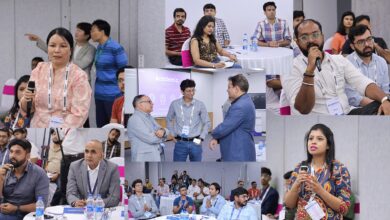[Into the Future With Samsung Research] Samsung R&D Institute India – Bangalore: Advanced Communication Networks Innovate the Daily Life of the Future

Samsung Newsroom is introducing tech experts from Samsung’s R&D centers around the globe to hear more about the work they do and the ways in which it is directly improving the lives of consumers.
The expert interviewed for the series is Ratnakar Rao V R, who heads the Beyond 5G Team at Samsung R&D Institute India – Bangalore (SRI-B). Rao is soon to complete a decade at SRI-B, and the bulk of his experience has been in the research and development of wireless communication technologies like 4G and 5G. Check out the interview below to find out more about the promising technologies Rao and his team have been working on.

Q: Advanced system software plays a crucial role in activating all kinds of technologies developed to provide better user experiences. How has research into applied AI been factoring into your work within the communications field?
Traditionally, all cellular communication systems were implemented using mathematical models and were strictly rule-based. However, this is now changing in the 5G era due to a few key factors.
Firstly, since a single network has to cater to a number of diverse use cases simultaneously, such systems cannot operate to the best of their capabilities if implemented based only on traditional modeling. Secondly, advances in computation algorithms and processor architectures are making it easier to run AI and machine learning models on a wider range of devices. Thirdly, wireless networks are being virtualized and are getting split into micro-services that run in the cloud. On-Device AI capabilities are also being added to wireless terminals. From 5G onwards, networks will be closely integrated with applications, making it necessary for them to be more contextually aware of users and applications in order to deliver personalized network experiences to all.
All these factors enable and necessitate broader use of AI and machine learning in next-generation wireless networks and terminals.
Q: Can you please briefly introduce SRI-B and the kind of work that goes on there?
The Samsung R&D Institute in Bangalore (SRI-B) has established five Centers of Excellence (CoEs) with the focus areas of Communication, Camera and Multimedia, On-Device AI, IoT and Services. SRI-B has experience executing projects from the research to market stage in each of these areas, and makes impactful contributions to Samsung product lines on the backs of these CoEs every year.
At the Communication CoE, SRI-B has dedicated teams working on mobile terminals, network RAN/core development and wireless standards. Strong synergy between these teams has resulted in the establishment of end-to-end domain expertise. In addition to this, we have recently seeded advanced communication research in a bid to make impactful contributions to Beyond 5G and 6G evolution.
Q: What kind of communication-related work are you and your team engaged in now?
Firstly, our team specializes in radio, data networking protocols and embedded modem system software. We craft the 5G radio experience for different markets around the world. Our team is engaged in the product development of 5G mobile terminals for a range of world-wide markets.
Secondly, we are engaged in advanced research and development surrounding communication protocols. Some of this work makes it into Samsung products as differentiating features and solutions. The rest of our work is aimed at creating standards and implementation IP (intellectual property) pertaining to Beyond 5G and 6G systems.

Q: How do you expect the Beyond 5G era to change the way users interact with technology in their day-to-day lives?
The early launches of non-standalone 5G have unlocked a lot of hitherto unused spectrum in mid and high bands and also enabled the re-farming of the existing 4G spectrum for use with 5G. Thus, the transition to a very high-capacity communication system is underway.
This massive addition of capacity will enable more users to connect more devices to the internet and bring the benefits of connectivity to the masses who live in rural areas. For regular users, these benefits will be evident in terms of very high-resolution streaming, faster downloads and uploads and real-time interactive gaming. They will also see mixed-reality experiences in video streaming and video calls.
The subsequent enhancements to 5G in the coming years will unlock consumer infotainment and a lot of other use cases. For example, the low-power, low-bandwidth features of IoT devices will help public services, the agricultural industry and factories automate for better efficiency. Likewise, satellite-based 5G will provide ubiquitous coverage all over the globe. The highly reliable, low-latency optimizations applied to 5G networks will also enable better remote delivery of services like healthcare and education.
Q: Which of SRI-B’s achievements in the communications field are you most proud of?
We at SRI-B are proud to have played a critical role in the launch of the world’s first 3G, 4G and 5G smartphones. Recently, SRI-B has enabled standalone 5G and 5G carrier aggregation in mobile terminals for commercial use, developed 4G and 5G network software and helped establish MC-PTT (Mission Critical Push to Talk) capabilities.
SRI-B has also been an IP powerhouse for several years. Every year, a number of IPs are created by SRI-B engineers from across the various domains. We have created more than 200 implementation IPs in the area of wireless communication, and more than 100 standard essential IPs in the areas of 4G and 5G.
Q: How does collaborating with other institutes like Samsung Research America, Samsung R&D Institute UK and Samsung Research in Korea complement your work and research capabilities?
We have worked closely with Samsung Research on early technology development and realization of 5G, and are now collaborating on nascent 6G technology development. I strongly believe that a lot of potentials can be unlocked by further collaboration between SRI-B and the teams at Samsung Research America and Samsung R&D Institute UK.
SRI-B has a very large pool of communication engineers, including innovators and domain experts. It is therefore possible to build high-quality teams and execute research promptly. We are actively exploring these possibilities by interacting with R&D leaders at global research centers to enable breakthrough innovations.

Q: How are AI and machine learning being applied to Beyond 5G and 6G wireless communication technology? How do you expect these technology combinations to evolve going forward?
It is widely agreed that AI and machine learning will have a significant influence on network management and radio resource management for Beyond 5G and 6G networks. We envisage AI and machine learning applications being present in block-level AI, procedural AI and system software AI, and are actively researching along these lines.
-
- Block-level AI: A specific block in the terminal or network could be added with AI/machine learning without impacting the rest of the system, resulting in performance improvements and/or computation savings. For example, a channel decoder could decide to terminate the decoder iterations early if it is able to predict whether the block decoding will eventually pass or fail.
- Procedural AI: This is where at least two entities in the end-to-end system exchange information to enable accurate use of AI and machine learning techniques. For example, meta-data needs to be exchanged between the terminal and network for an auto encoder or decoder to work within a margin of error. Another example is mobility management for terminals.
- System software AI: Most entities in next-gen communication systems will have to operate in several modes. The embedded system software should be able to scale up or scale down system resources very dynamically. AI-assisted embedded system software is expected to learn context-specific requirements and adapt accordingly.
Q: You are a senior member of the Institute of Electrical and Electronics Engineers (IEEE). What kind of activities are you involved with in this role? How does your position in the IEEE inform your other work?
In this role, I deliver invited lectures and talks on various technology topics for the student communities and teach fraternities at regional engineering colleges. The role has also enabled me to seed new study items internally, allowing us to initiate new collaborations with student communities and faculties from reputed universities.
The aim is to influence as many people as possible to improve their domain expertise and pursue advanced research in the communications field. I also represent Samsung in various talks and discussions with industry, government and academia. My interactions help me stay in touch with the latest trends in various areas adjacent to my area of expertise.
I also encourage my team members to publish their results in outstanding conferences and journals. This year and last year, we have published more than 20 papers in various outstanding forums.



